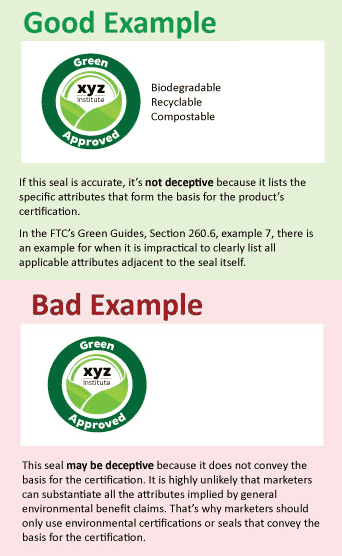Updated to clarify that this post is not about Green Seal, Inc. but the environmental seals or certifications warned against in a recent FTC update.
Manufacturers of consumer products labeled with unspecified environmental certification seals (“green seals”) may find themselves subject to increasing FTC scrutiny and false labeling claims. This past month, the FTC sent warning letters to 32 unidentified manufacturers of consumer products utilizing green seals addressing the Agency’s position that the subject seals may be considered deceptive pursuant to the FTC’s Green Guides.
The FTC’s refreshed “Green Guides” contain a new section on environmental certifications and seals of approval. 16 C.F.R. § 260.6. The Green Guides distinguish acceptable Seals from potentially problematic seals, and the difference hinges on qualifying language. An “unqualified” general environmental benefit claim, such as “green” or “eco-friendly,” fails to explain why a product earned a green seal. Claims, therefore, must be qualified and provide information to consumers as to why a product earned its seal. A product can be deserving of a green seal for numerous reasons, but the FTC explained that it is “highly unlikely” that a single product can “substantiate all the attributes” implied by a general claim that it is environmentally friendly. Therefore, a qualifying descriptor is necessary to avoid any deception. Any potential deception is unmasked if the seal is coupled with representations such as “biodegradable” or “compostable.” Such qualifying language should be clearly and prominently displayed on the product packaging. A “Green Approved” seal unaccompanied with any additional description is, according to this new guidance, potentially deceptive. The FTC posted a business blog post, “Performing Seals,” to provide additional assistance to businesses utilizing green seals. See https://www.ftc.gov/news-events/blogs/business-blog/2015/09/performing-seals. Below is an example of a good vs a bad green seal, according to the FTC:
While the FTC is not presently taking action against the targeted companies, that does not mean that consumers will follow the Agency’s lead. Often times an agency’s action and news coverage highlighting potentially deceptive business practices narrows the focus of litigious consumers. For example, this past spring, the FDA issued a warning letter to KIND, LLC, manufacturer of popular fruit and nut snack bars, regarding its labeling practices. Within days, consumer class actions were filed against the company for deceptive business practices. Similarly, the FDA’s June announcement stating that within two years trans-fats must be eliminated from processed foods spurned false labeling and deceptive business practices litigation despite that products were in compliance with current regulations. Even without disclosing the identity of companies which received FTC letters last month, the Agency has brought attention to unqualified labeling which could prompt consumers to look twice at packaging. This brings to the fore all products bearing green seals.
Taking things a step further, just this week the FTC affirmed that ECM BioFilms, Inc. actually made deceptive claims about a chemical additive by labeling it “biodegradable.” In the Matter of ECM BioFilms Inc. d/b/a Enviroplastics International, Docket No. 9358, before the U.S. Federal Trade Commission. The Agency stated that “biodegradable” may only be used if a products breaks down entirely “within five years.” In this decision, the FTC emphasized that customers often rely on environmental-claims while being unable to test them or “readily judge for themselves the truth or falsity” of such claims. This kind of analysis makes environmental claims especially vulnerable to attack. This ECM decision is a clear shot across the bow of companies utilizing green seals. Not only does the seal need to be qualified, but according to ECM, any qualifying terms must apparently accurately reflect the properties of the product in a readily verifiable way.
The FTC’s “Green Guides” clocks in at over 300 pages making it by no means a quick-read or pocket resource. While this guidance is certainly helpful, this landscape is shifting. It is therefore in a company’s best interests to proactively engage experienced counsel to review your green seal advertising and marketing program to best guard against this increased liability risk.


